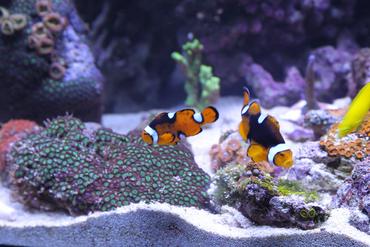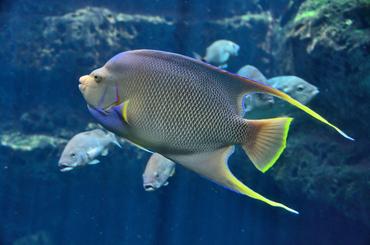KEEPING AND BREEDING MANDARINFISH

Updated
Mandarinfish are a small, colorful species of saltwater aquarium fish. Read more to learn how to care for and breed these fish in the home aquarium.
Stocking the saltwater aquarium can be quite a challenge simply because there are so many options to choose from. There are thousands of species of saltwater aquarium fish and new species are being discovered every year. When selecting the stock for your tank you need to think about the particular type of tank environment you intend to cultivate – some species prefer reef environments while others prefer open swimming space. Because tank requirements vary so greatly from one species to another, it is sometimes a good idea to start with one species and design your tank around that species, finding compatible tank mates along the way.
If you choose to go with this option, the mandarinfish is a great species to start with. Not only are these fish incredibly colorful, spotted with vibrant hues, but they are actually fairly hardy in the home aquarium. Mandarinfish are not large so they can be cultivated in traditional saltwater tanks as well as nano tanks. This species is one of the most popular species sold in the saltwater aquarium hobby and for good reason – they are a joy to keep and they bring a splash of color to the reef tank. If you like the sound of these little fishes, read more to learn how to keep them and breed them at home.
About Mandarinfish
The mandarinfish (Pterosynchiropus splendidus) is known by a number of nicknames including mandarin dragonet, mandarin goby, green mandarinfish and psychedelic fish. The name psychedelic fish is derived from the bizarre coloration exhibited by this species. Mandarinfish typically have a blue or green scale-less body ornamented with wavy orange stripes and bright blue edging on the fins. Though they are similar in appearance to gobies and are, in fact, sometimes called mandarin gobies, these fish belong to a different family by the name of dragonets. These fish are native to the Philippines and western Australia where they can be found living in groups or pairs on the sandy bottoms between reefs.
These fish remain fairly small, typically growing to a maximum length around 3 inches, which makes them a popular choice for nano reef tanks. Not only do mandarinfish stay small, but they are also fairly peaceful in the home tank. Males of the species, however, will fight if more than one male is kept in the same tank. In addition to being peaceful fish, mandarinfish are also very active and they seem to be resistant to certain aquarium fish diseases like Ich. The most unique characteristic of these fishes is, of course, their unusual coloration.
Tank Requirements and Care
If you do some basic research on mandarinfish you will find differing opinions regarding their hardiness in the home aquarium. In many cases, those who label the mandarinfish as difficult to keep do so because of their strict eating habits. Under the right conditions, however, mandarinfish can be very hardy and not especially difficult to keep. Though mandarinfish remain small, they require a minimum tank size of 55 gallons – a large tank is required to cultivate a sufficient population of the tiny organisms mandarinfish like to eat. The tank should be set up with a lot of live rock to provide the fish with places to hide and, ideally, sandy substrate that the fish can burrow into if they want to.
The ideal temperature range for this species is between 76° and 82°F. Though they can be hardy, mandarinfish do best with a specific gravity between 1.023 and 1.026 as well as a dKH between 8 and 12. The ideal pH range for mandarinfish is 8.1 to 8.4. Again, mandarinfish may be able to tolerate slight variation in tank conditions but it is essential to maintain high water quality and a proper nutrient balance in order to cultivate a sufficient population of the organisms mandarinfish feed on. Because mandarinfish are often found in areas subjected to strong waves, many aquarium hobbyists suggest that they prefer a tank with a great deal of aeration and water flow. Mandarinfish can be very sluggish and slow at times, however, so it is wise to turn off the aeration during feeding times so your mandarinfish is able to catch its prey.
Feeding Mandarinfish
Many aquarium hobbyists have labeled the mandarinfish as difficult to keep, simply because this species requires a very specific diet and they can be fairly picky. Mandarinfish have very small mouths so they must eat very small foods – this also means that they spend a large part of their day foraging for food. Because most mandarinfish available for the aquarium trade are wild-caught, they generally do not accept commercial foods. Over time, some specimens will adapt to a commercial diet but many mandarinfish never do. Some fish refuse to eat anything but the food they would find in their natural habitat.
In the wild, mandarinfish feed on copepods and amphipods. Copepods are simply small aquatic crustaceans that can be found in most freshwater and marine environments – these creatures feed on algae and are an important food source for many saltwater aquarium fish. Amphipods are another type of small crustacean that have no carapace. In their natural habitat, mandarinfish graze for these foods throughout the day so they are most likely to thrive in an aquarium that provides similar conditions. Some mandarinfish will accept brine shrimp or certain frozen foods like bloodworms, but not every specimen will. One way to ensure that your mandarinfish always have a ready supply of food is to create a breeding ground for copepods in one area of your tank. Simply stack a pile of rocks and, every few days, insert a piece of shrimp into the pile. This pile will provide both the food and shelter copepods need to breed in your tank.
Breeding Information
Before you can think about breeding your mandarinfish you need to learn some of the basics. The first think you need to learn is how to tell your male mandarinfish apart from the females. Not only do male mandarinfish tend to grow a little larger than the females but they also may develop an elongated dorsal spine and a larger dorsal fin. In order to successfully breed your mandarin fish you must first establish a breeding pair. If you already have a male and female in your tank you may be able to condition them for spawning – otherwise, you may need to purchase a mated pair to increase your chances for success. Mandarinfish have been spawned successfully in captivity but it all depends on creating the right conditions.
To protect the fry of your mandarinfish from other fish in your tank, it is wise to create a separate breeding tank. This tank should be set up with similar conditions to the main tank in terms of water chemistry but no additional spawning surfaces are required because the eggs will simply float until they hatch. Spawning can actually occur as often as once a week for several months at a time – mandarinfish have been known to spawn all year-round. This species exhibits pelagic spawning which simply means that fertilization occurs externally. In the wild, spawning typically takes place at night when groups of male and female mandarinfish gather several feet above the reef to spawn. The females are only capable of spawning once in any given night but males have been known to compete for the available female partners.
Breeding in the Wild
A recent article published in National Geographic goes into depth about the mating rituals of the mandarinfish. These little fish exhibit a surprisingly structured social and mating system and individuals of the species have been seen to display stark differences in personality from other mandarinfish. During the study, researchers found that groups of 3 to 5 female mandarinfish would gather within 20 minutes of sunset, waiting for a male to catch their eye. At this time, the male mandarinfish would display a variety of courtship behaviors until he snagged a female. Then, the female would rest on the pelvic fin of the male and swim with him to about a meter above the coral reef at which point they would simultaneously release the eggs and sperm.
A single egg typically measures between 0.7 and 0.8 mm in diameter and they are generally colorless. The average clutch consists of around 200 eggs which are spherical in shape and drift around in the ocean until hatching. At first, the eggs may clump together but they will eventually be separated by the current. Adult mandarinfish do not exhibit any parental care after spawning has occurred. The eggs typically hatch within 12 hours after fertilization and within 36 hours, the eyes and mouth will already be well developed. Juvenile mandarinfish will look like miniature copies of adult mandarinfish after about 2 weeks and, around three weeks, they will begin to develop the iconic orange and green coloration.
There are many reasons why you might consider adding a mandarinfish or two to your tank. Not only are these fish hardy in the home aquarium and resistant to parasitic disease, but they also add a pop of unexpected color to your tank. Not many species of fish display such a vibrant combination of colors as the mandarinfish – bright blue mixed with oranges, reds and even yellows. If you plan to keep mandarinfish in your tank, take the time to learn the basics about this species so you can be sure to provide them with an adequate tank environment. The closer your tank resembles the natural environment of the fish you are keeping, the healthier and happier your fish are likely to be. And remember, when your fish are happy you will be happy too.































































































